
German Beef Breeds
German Gelbvieh
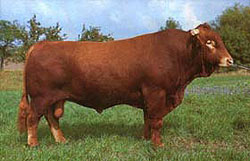
German Gelbvieh is a beef orientated dual-purpose breed. The breeding area is mainly located in Northern Bavaria. The self-coloured cattle appear from light yellow to red-yellow colour. The total pigmentation of the animals protects against intensive sun radiation in tropical and subtropical areas.
The aim is a cow with long productive life and regular calving, which is also ideally suited as pedigree suckler cow and for commercial crossing with dairy and beef breeds.
High milk yield provides for calf growth without problems and guarantees outstanding weaning weights. The breed benefits from good adaptability to varying climatic and management conditions. Clean feet with dark, hard claws, calm temperament in connection with good mothering ability make the Gelbvieh a partner of professional beef cattle producers.
| Facts & Figures: | 2011 |
| population in total: | ~ 15.000 |
| cows in herdbook: | 2.203 |
| calving interval (days): | 403 |
| first calving age (months): | 30,5 |
| Ø milk production (kgs/lactation): | 5.737 |
| Ø fat content (%): | 4,18 |
| Ø protein content (%): | 3,49 |
| male | female | |
| stature (cm): | 148-160 | 138-145 |
| live weight (kg): | 1.100-1.350 | 700-850 |
| daily gains (g/day): | > 1.300 | > 1.100 |
German Angus

The genetically polled, self-coloured beef breed has an extended, well-muscled body and full- deep-reaching haunches. Early-maturity, fertility, calving ease, mothering ability and best rearing performance thanks to high lactation persistency are typical traits of the German Angus cow. In addition, a speedy development with high daily gains at good feed conversion and well-shaped, high quality carcass are the breeding goals. At an appropriate herd management with autumn- and winter-calving, an efficient utilization of the long-lasting nursing performance contributes to the development of weaners that obtain three fifths of their finishing weight out of roughage and grazing. A short, restrained final fattening period results in the desired carcass that can be achieved for young or a little older Angus with less intensive fattening rations. German Angus are bred for black and red colour.
Breed profile:
- medium-intensive beef breed
| male | female | |
| Birth weight (kg): | 35 | 32 |
| Stature (cm): | 135-150 | 125-140 |
| Live weight (kg): | 900-1.100 | 550-700 |
| Age at first calving (months): | 24-27 |
German Charolais
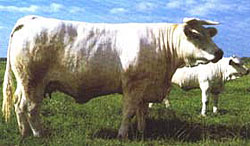
German Charolais are noted for their good mothering ability, high rearing performance, outstanding grazing ability and a good-natured character. The animals are particularly suitable for finishing at intensive arable-farming locations. Over the entire fattening period, daily gains of 1,500 g are the rule. With that, the final weights of between 650 and 700 kg presently aimed at can be achieved at 16 months of age. Animals ready for the slaughter provide slightly marbled beef without thick fat cover and significant deposits of fat. Due to the good adaptability of the breed, female feeder cattle or oxen can be finished at less intensive locations, too.
Breed profile:
- intensive beef breed
| male | female | |
| Birth weight (kg): | 44 | 40 |
| Stature (cm): | 145-155 | 140-150 |
| Live weight (kg): | 1.200-1.400 | 800-1.000 |
| Age at first calving (months): | 33-36 |
German Limousin
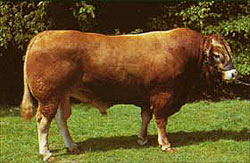
German Limousin is bred for a good development of length and width. The bone quality is fine, the muscular system, especially of the hind quarters, is distinct. A long, slightly sloped and wide rump is desired to support easy calving. Within the field of steer fattening which is supposed to be completed at 18 months of age, average daily gains of from 1,100 to 1,300 g are aimed for. The milk yield must be sufficient for a successful development of the calves.
The breed possesses tremendous vitality. It is recommendable for the use in poor grassland regions where suckler herds are kept with minor monitoring efforts, especially at calving. The carcasses show minor shares of bones and tendons and have an insignificant fat cover. Fat deposit in the valuable parts is good.
Breed profile:
- medium-intensive beef breed
| male | female | |
| Birth weight (kg): | 39 | 36 |
| Stature (cm): | 147 | 138 |
| Live weight (kg): | 1.100 | 700 |
| Age at first calving (months): | 30-36 |
German Blonde d’Aquitaine
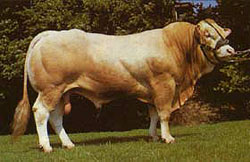
Blonde d’Aquitaine cattle from Germany are known for their unproblematic keeping, the suckler herds are calm and adapt easily to different conditions of climatics and feeding. The cattle allows an extensive keeping on grassland during the summer and a feeding of hey or grassilage during the wintertime. The breed show its’ enormous fattening potential under intensive feeding where young bulls achieve daily gains of up to 2,000 g.
Blonde d’Aquitaine cattle are uniform light-yellow to wheat-colour and belong to the big-sized and intensive beef breeds. They show a long and symmetrical body, especially well-muscled on haunches, back and shoulders.
Breed profile:
- medium-intensive beef breed
| male | female | |
| Birth weight (kg): | 46 | 41 |
| Stature (cm): | 155-170 | 140-150 |
| Live weight (kg): | 1.100-1.300 | 850-950 |
| Age at first calving (months): | 32-33 |
German Hereford

The colour of the medium-sized Hereford is between brown and reddish brown. The dominantly transmitted white head is a notable trait. Throat, belly and swith are white, too. A white nape line and an unpigmented muzzle are desired.
Importance is attached to a harmonious, well-proportined body. The animals should show a good carcass gain without perceptible fat deposits. A deep body has to ensure high roughage intake capacity. Sound limbs and firm hooves with high heels are desired. Horned as well as genetically polled animals are bred.
Under German conditions, the daily gain of young bulls amounts to approximately 1.100 g. The good fattening efficiency and carcass yield has resulted in the fact that in Germany, the breed increasingly is gaining importance both purebred and crossbred with local dairy and beef breeds. The use of this robust breed in conservation areas has proven successful.
Breed profile:
- medium-intensive beef breed
| male | female | |
| Birth weight (kg): | 36 | 33 |
| Stature (cm): | 140-155 | 130-140 |
| Live weight (kg): | 900-1.300 | 600-700 |
| Age at first calving (months): | 24 |
German Galloway
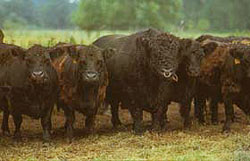
Breeding goal of the German Galloway breed are resistant and undemanding cattle known for very good feed conversion as well as a quiet and gentle disposition. Good mothering ability and a close relationship to the herd are additional outstanding traits of the breed. On top of it, the animals are long-lived, late maturing, fertile and easy calving. On account of their robustness, Galloways are able to adapt to the most varying management conditions.
As a result of their modest requirements and sturdy health, the breed is of special significance for the conservation of countryside and nature.
Galloways from Germany are genetically polled and comes out in black, dun, red, white and belted. The animals show a generally deep, compact symmetrical body with well-muscled shoulders. The rear haunches have to be full-beefy, the tighs wide and straight. The legs are short with small bones, the coat is soft with especially thick underhair.
Breed profile:
- extensive beef breed
| male | female | |
| Birth weight (kg): | 30 | 27 |
| Stature (cm): | 128 | 120 |
| Live weight (kg): | 800 | 550 |
| Age at first calving (months): | 33 |
German Highland cattle
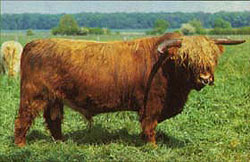
Highland Cattle are suitable for extensive beef production on pasture, but not for intensive fattening. At an age between 24 and 30 months; the bulls and oxen are prime for the slaughter. The animals' modest requirements allow year-round grazing even at less favourable locations . Keeping animals outdoors favours their utilisation in conservation of the countryside.
Breed profile:
- ekstensive beef breed
| male | female | |
| Birth weight (kg): | 25 | 22 |
| Stature (cm): | 125-135 | 110-120 |
| Live weight (kg): | 650-750 | 450-550 |
| Age at first calving (months): | 39 |
German Salers
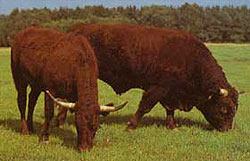
Salers cattle are known for their longevity, good feed conversion and adaptability to various climatic and management conditions. The cows are noted for their relatively high milk yields and mothering ability. The long and wide rump supports easy calving, also at crossing with big-sized breeds.
Salers are suitable to keep outside during the whole year or, because of their hard black hooves, as well in any barn system. At intensive fattening, daily gains of 1,300 g are the rule with a slaughter result of about 60 %.
Breed profile:
- medium-intensive beef breed
| male | female | |
| Birth weight (kg): | 39 | 36 |
| Stature (cm): | 148-155 | 138-145 |
| Live weight (kg): | 900-1.100 | 650-850 |
German Piemontese
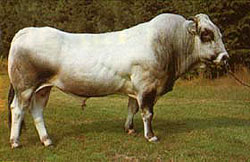
The Piemontese is an early maturing and long living breed with easy adaptability to many different conditions or types of climate. It adapts to confined rearing as well as to open or semi-open herding systems. Very good gains are possible, especially in intensive fattening. High slaughter results with best beef quality is also achieved in extensive systems.
The medium-sized Piemontese cattle have an extended body that is plastically muscled on all beefy parts. At crossing with dairy- or beef-breeds, the Piemontese transmits it’s beef quality, slaughter results and the insignificant fat cover.
Breed profile:
- medium-intensive beef breed
| male | female | |
| Birth weight (kg): | 42 | 38 |
| Stature (cm): | 150 | 135-140 |
| Live weight (kg): | 950-1.150 | 650-750 |
German Welsh Black
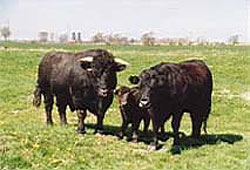
Welsh Black was shaped over many decades by the harsh climate and very frequently bad pasture quality in their native country. The result of this selection by nature is the animals' modest requirements and dealing with bad environmental conditions over short periods. The animals are known by outstanding fertility and longevity. Welsh Black are appropriate for extensive beef production on pasture, while utiliziting in conservation of the countryside.
Breed profile:
- extensive beef breed
| male | female | |
| Birth weight (kg): | 38 | 35 |
| Stature (cm): | 142 | 132 |
| Live weight (kg): | 1.000 | 650 |

 our livestock
our livestock